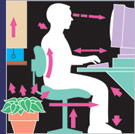
Ultimate
Tips for a More Comfortable Workspace
reprinted with permission
from the HP Small Business Center
 Work is
stressful enough without the added annoyance of an aching
back, cramped fingers and a sore neck. But the fact is that
people who are generally sedentary -- which can include
anyone who spends most of their day behind a desk -- is at
risk of developing these sorts of problems, as well as more
serious conditions like carpal tunnel syndrome or repetitive
stress injuries.
Work is
stressful enough without the added annoyance of an aching
back, cramped fingers and a sore neck. But the fact is that
people who are generally sedentary -- which can include
anyone who spends most of their day behind a desk -- is at
risk of developing these sorts of problems, as well as more
serious conditions like carpal tunnel syndrome or repetitive
stress injuries.
Ready to feel more comfortable at work? Then read on to discover how a few simple changes to your workspace can make a big difference.
1. It's all
in the wrist
Wrist pain and cramping often occur after long periods of
working at a computer. To combat this problem, try using the
lightest possible grip on your mouse, or skip the mouse
altogether and use a touchpad. You can also try alternating
between the two.
When you're typing, be sure your hands are level with or slightly lower than your elbows. Rest your hands frequently, and especially at the first sign of wrist pain or cramping. Wrist-rests can help support good typing techniques.
2. Have a
seat (a good one, that is)
The quality of your desk chair is important. You wouldn't
think that sitting puts a strain on your back, but it does
--
and this can be mitigated with a desk chair that supports
your lower back. When seated, you'll also want to make sure
that your feet are comfortably resting flat on the floor,
and that the natural hollow of the chair stays in your lower
back. Armrests are another important feature of the ideal
desk chair; rest your elbows on the armrests and adjust so
that the weight of your arms isn't supported by your
shoulders. Additionally, a chair with a range of motion
(i.e. adjustable) is best.
3. The "write" stuff
Most of us type more than we write things by hand, but if
you do a lot of writing you might want to try larger-barrel
pens. These are easier to grip and prevent hand cramps.
4. Monitor
your settings
The proper placement of your monitor screen is an important
element in avoiding neck pain. Be sure it's always at eye
level so you aren't bending your neck up or down, and keep
it right in front of you rather than off to the side.
You'll also want to check your monitor settings to ensure you're not causing eye strain. Adjust the brightness settings, and use a glare filter if necessary. Perhaps most important, take frequent breaks from staring at the screen so your eyes can rest.
5. Lighten
the mood
Lighting doesn't just play a role with your vision -- studies
have shown that it can have a positive or negative impact on
your mindset as well. The fluorescent lighting so common in
offices can often create a great deal of eye strain by
making your computer monitor difficult to see -- so if
possible, switch off or dim the overhead lights in your area
and use a sufficiently powerful desk lamp instead. When you
can, sit in or near natural sunlight, which is generally
easier on the eyes and has a positive impact on your mood.
6. Give
yourself some room
In a world of cubicles, it can be difficult to spread out
and get comfortable. But whenever you can, try to set up a
workspace that is large enough for you to have a full range
of motion. And don't forget to leave plenty of room to
organize your most frequently used items so that you're not
always standing on tiptoe or bending down to reach them.